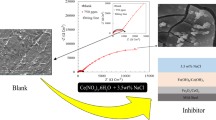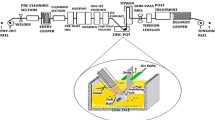Abstract
The micro-structural effects on the corrosion resistance of three classes of mild steels (A, B and C) suitable for galvanizing industry, according to their silicon, phosphorus content, grain number and size of carbides (Fe3C) in concentrated hydrochloride acid solution was investigated by a series of known techniques, such as potentiodynamic polarization curves, electrochemical impedance spectroscopy measurements, optical microscope and scanning electron microscopy. Results showed that the corrosion rate of the three classes of mild steel depends on their silicon and silicon/phosphorus combinations contents. It is found also that the corrosion rate depends on grain number and size of carbide content in mild steels. These findings were confirmed by micro-structural characterization and scanning electron microscopy techniques. They indicated that the severe corrosion cavities formed on the carbon steel surfaces and their sizes depended to silicon and silicon/phosphorus combinations contents. These results explained by micro-galvanic corrosion process between cementites and ferrites which became more serious with silicon and silicon/phosphorus combinations contents.













Similar content being viewed by others
References
Abdulrahaman MA, Abubakre OK, Abdulkareem SA, Tijani JO, Aliyu A, Afolabi AS (2017) Effect of coating mild steel with CNTs on its mechanical properties and corrosion behaviour in acidic medium. Adv Nat Sci Nanosci Nanotechnol 8(1):015016. https://doi.org/10.1088/2043-6254/aa5cf8
Sivkov A, Shakenkov I, Park A, Geracimov D, Shanenkwa Y (2016) Deposition of a TiC/Ti coating with a strong substrate adhesion using a high-speed plasma jet. Surf Coat Technol 291:1–6
William DC, David GR (2009) Material science and engineering: an introduction, 8th edn. Wiley, New York, pp 141–155
Alaoui K, El Kacimi Y, Galai M, Serrar H, Touir R, Kaya S, Kaya C, Ebn Touhami M (2020) New triazepine carboxylate derivatives: correlation between corrosion inhibition property and chemical structure. Int J Ind Chem 11:23–42. https://doi.org/10.1007/s40090-019-00199-5
Oyetunji A, Adeosun SO (2012) Effects of carburizing process variables on mechanical and chemical properties of carburized mild steel. J Basic Appl Sci 8:319–324
Philip AS (2010) Fundamental of corrosion; mechanism, causes and preventive methods. CRC Press, Boca Raton, pp 14–25
Herrag L, Hammouti B, Elkadiri S, Aouniti A, Jama C, Vezin H, Bentiss F (2010) Adsorption properties and inhibition of mild steel corrosion in hydrochloric solution by some newly synthesized diamine derivatives: experimental and theoretical investigations. Corros Sci 52:3042–3051
Jayaperumal D (2010) Effects of alcohol-based inhibitors of corrosion of mild steel in hydrochloric acid. Mater Chem Phys 119:478–484
El Kacimi Y, Azaroual MA, Touir R, Galai M, Alaoui K, Sfaira M, Ebn Touhami M, Kaya S (2017) Corrosion inhibition studies for mild steel in 5.0 M HCl by substituted phenyltetrazole. Euro-Mediterr J Environ Integr 2:1–23
Alaoui K, El Kacimi Y, Galai M, Dahmani K, Touir R, El Harfi A, El Ebn Touhami M (2016) Poly (1-phenylethene): as a novel corrosion inhibitor for carbon steel / hydrochloric acid interface. Anal Bioanal Electrochem 8:830–847
Negm NA, Elkholy YM, Zahran MK, Tawfik SM (2010) Corrosion inhibition efficiency and surface activity of surface active benzothiazol-3-ium cationic Shiff base derivatives in hydrochloric acid. Corros Sci 52:3523–3536
Singh AK, Quraishi MA (2010) Investigation of adsorption of isoniazid derivatives at mild steel/hydrochloric acid interface: electrochemical and weight loss methods. Mater Chem Phys 123:666–677
Bentiss F, Outirite M, Traisnel M, Vezin H, Lagrenée M, Hammouti B, Al-Deyab SS, Jama C (2012) Improvement of corrosion resistance of carbon steel in hydrochloric acid medium by 3,6-bis(3-pyridyl)pyridazine. Int J Electrochem Sci 7:1699–1723
El Kacimi Y, Touir R, Galai M, Belakhmima RA, Zarrouk A, Alaoui K, Harcharras M, El Kafssaoui H, Ebn Touhami M (2016) Effect of silicon and phosphorus contents in steel on its corrosion inhibition in 5 M HCl solution in the presence of Cetyltrimethylammonium/KI. J Mater Environ Sci 7(1):371–381
Stern M, Geary AL (1957) Electrochemical polarization I. A theoretical analysis of the shape of polarization curves. J Electrochem Soc 104:56–63
El Faydy M, Galai M, El Assyry A, Tazouti A, Touir R, Lakhrissi B, Ebn Touhami M, Zarrouk A (2016) Experimental investigation on the corrosion inhibition of carbon steel by 5-(chloromethyl)-8-quinolinol hydrochloride in hydrochloric acid solution. J Mol Liq 219:396–404
Adardour K, Touir R, El Bakri M, Larhzil H, Ebn Touhami M, Ramli Y, Zarrouk A, El Kafsaoui H, Essassi EM (2015) Thermodynamic properties and comparative studies of quinoxaline derivatives as a corrosion inhibitor for mild steel in 1 M H2SO4. Res Chem Intermed 41:1571–1589
Kissi M, Bouklah M, Hammouti B, Benkaddour M (2006) Establishment of equivalent circuits from electrochemical impedance spectroscopy study of corrosion inhibition of steel by pyrazine in sulphuric acidic solution. Appl Surf Sci 252:4190–4197
Lopez DA, Simison SN, de Sanchez SR (2005) Inhibitors performance in CO2 corrosion: EIS studies on the interaction between their molecular structure and steel microstructure. Corros Sci 47:735–775
Lopez DA, Simison SN, de Sanchez SR (2003) The influence of steel microstructure on CO2 corrosion. EIS studies on the inhibition efficiency of benzimidazole. Electrochim Acta 48:845–854
Gerengi H, Darowicki K, Bereket G, Slepski P (2009) Evaluation of corrosion inhibition of brass-118 in artificial seawater by benzotriazole using dynamic EIS. Corros Sci 51:2573–2579
Touir R, Larhzil H, Ebn Touhami M, Cherkaoui M, Chassaing E (2006) Electroless deposition of copper in acidic solutions using hypophosphite reducing agent. J Appl Electrochem 36:69–75
Popova A, Christov M, Vasilev A (2011) Mono- and dicationic benzothiazolic quaternary ammonium bromides as mild steel corrosion inhibitors. Part II: electrochemical impedance and polarisation resistance results. Corros Sci 53:1770–1777
Khaled KF, Al-Qahtani MM (2009) The inhibitive effect of some tetrazole derivatives towards Al corrosion in acid solution: chemical, electrochemical and theoretical studies. Mater Chem Phys 113:150–158
Maalekian M, Lendinez ML, Kozeschnik E, Brantner HP, Cerjak H (2007) Effect of hot plastic deformation of austenite on the transformation characteristics of eutectoid carbon steel under fast heating and cooling conditions. Mater Sci Eng A 454–455:446–452
Barmatov E, Hughes TL (2017) Effect of corrosion products and turbulent flow on inhibition efficiency of propargyl alcohol on AISI 1018 mild carbon steel in 4 M hydrochloric acid. Corros Sci 123:170–181
Farelas F, Galicia M, Brown B, Nesic S, Castaneda H (2010) Evolution of dissolution processes at the interface of carbon steel corroding in a CO2 environment studied by EIS. Corros Sci 52:509–517
Ochoa N, Vega C, Pébère N, Lacaze J, Brito JL (2015) CO2 corrosion resistance of carbon steel in relation with microstructure changes. Mater Chem Phys 156:198–205
Crolet J, Thevenot N, Nesic S, NACE International (1998) Role of conductive corrosion products in the protectiveness of corrosion layers. Corrosion 54(3):194
Paolinelli LD, Perez T, Simison SN (2008) The effect of precorrosion and steel microstructure on inhibitor performance in CO2 corrosion. Corros Sci 50:2456–2464
Nesic S, Thevenot N, Crolet J, Drazic D (1996) Electrochemical properties of iron dissolution in the presence of CO2—basics revisited. Corrosion 96:6615–6638
Ferhat M, Benchettara A, Amara SE, Najjar D (2014) Corrosion behaviour of Fe-C alloys in a Sulfuric Medium. J Mater Environ Sci 105:1059–1068
Tarasova NV, Saltykov SN (2007) Specifities of forming electrochemical dissolution zones at ferrite-cementite-structured alloys in sulfuric acid solutions. Prot Metals 43:231–234
Tarasova NV, Saltykov SN (2006) Anodic dissolution of ferrite phases from iron-carbon ferrite-cementite alloys with different forms of cementite. Prot Metals 42:501–506
Hofer LJE (1966) Nature of the carbides of iron Bureau of mines, US Department of the Inventors. Bulletin 631
Kosolapova TY (1971) Carbides: properties, production, and applications. Plenum Press, New York, p 298
Staicopolus DN (1962) The computation of surface tension and of contact angle by the sessile-drop method. J Colloid Sci 17:439–447
Staicopolus DN (1963) The computation of surface tension and of contact angle by the sessile-drop method (II). J Colloid Sci 18:793–794
Schenk R, Stenkhoff R (1927) Über die Säurezerlegung des Eisencarbides. Zeitschrift für anorganische und allgemeine Chemie 161:287–303
Schmahl GN, Dillenburg, H (1969) Gleichgewichtsuntersuchungen an eisenoxidhaltigenMischphasen innerhalb der Dreistoffsysteme Fe-Al-O, Fe-Cr-0 und Fe- V-0.Z Elektrochem 40:68. Zeitschrift fur Physikalische Chemie 65:119–138
Schmidt J (1934) On the decomposition by carbides in presence of water or dilute acids. Z Elektrochem 40:170
Saltykov SN, Makarov GV, Toroptseva EL, Ya Filatova B (2004) Anodic behavior of white iron phases in oxalic media. Prot Metals 40:56–61
Syugaev V, Lomaeva SF, Reshetnikov SM, Shuravin AS, Sharafeeva EF, Surnin DV (2008) The effect of the structure-phase state of iron-cementite nanocomposites on local activation processes. Prot Metals 44:367–371
Mora-Mendoza JL, Turgoose S (2002) Fe3C influence on the corrosion rate of mild steel in aqueous CO2 systems under turbulent flow conditions. Corros Sci 44:1223–1246
Tang J, Shao Y, Zhang T, Meng G, Wang F (2011) Corrosion behaviour of carbon steel in different concentrations of HCl solutions containing H2S at 90 °C. Corros Sci 53:1715–1723
Author information
Authors and Affiliations
Corresponding author
Additional information
Publisher's Note
Springer Nature remains neutral with regard to jurisdictional claims in published maps and institutional affiliations.
Rights and permissions
About this article
Cite this article
El Kacimi, Y., Touir, R., Galai, M. et al. Relationship between silicon, phosphorus content and grain number in mild steels and its corrosion resistance in pickling hydrochloric acid. Int J Ind Chem 11, 111–122 (2020). https://doi.org/10.1007/s40090-020-00206-0
Received:
Accepted:
Published:
Issue Date:
DOI: https://doi.org/10.1007/s40090-020-00206-0




